18 Exciting Winter Photography Tips and Ideas
Winter may not seem like the best time of year to have exciting photo shoots and take gorgeous photos.
In reality, it’s the best season for creating surreal, and dreamy images.
To make the most out of winter photography, take a look at our 18 tips and creative ideas.
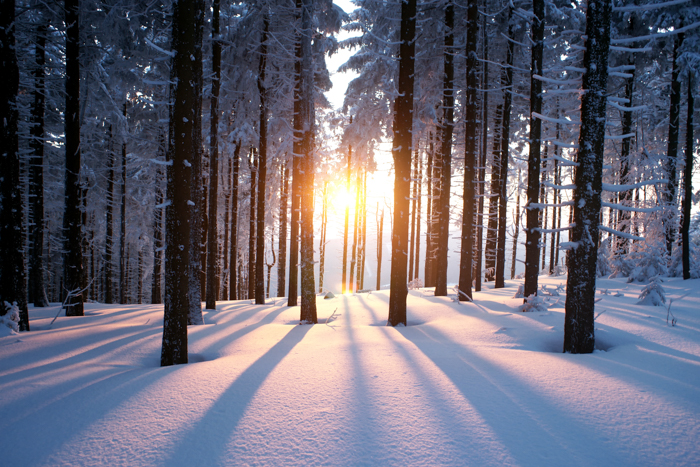
1. How to Prepare Yourself and Your Camera for the Cold Weather
You’re probably already aware that winter can be cold! You have to prepare for that if you are interested in winter photography.
Your camera can work slower in cold weather conditions. Spare batteries for being able to shoot everything you planned, as they rapidly run out.
Also, take a hot beverage with yourself in a thermos. And of course, dress properly, wear the warmest clothes you can. Especially if you are planning to stay put in one place, rather than hiking!
Fingerless gloves can make your task easier because you will be able to adjust your camera settings more easily.
After shooting outdoors, make sure to let your camera to try out. Moist can find it’s way into your lens and the camera body.
Although it doesn’t feel the same as rain, snow can soak your gear as well. Even if it’s not snowing, when you go into a warm place, you can immediately see the moist on your glass.
Don’t pack it immediately, let it dry in a warm (but not too hot) place. This way you can avoid getting camera lens fungus.
These are the base of every other winter photography tips for outdoor ideas.
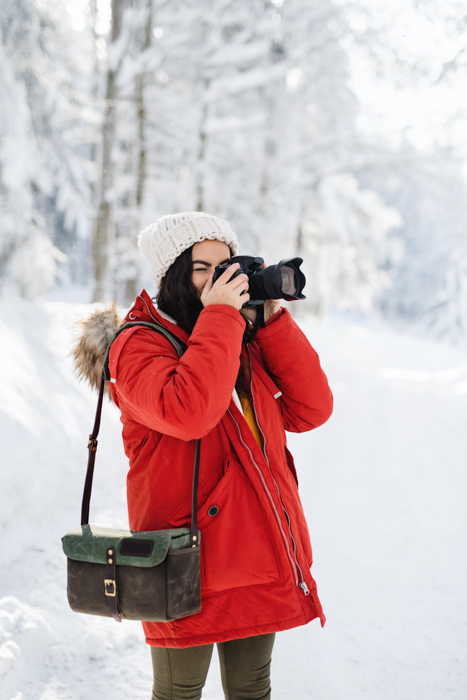
2. Use Your Camera Settings for Enhancing Soft Lights
Shooting in snow is a great challenge as a great part of your images is going to be bright and white.
You can overexpose your photos in wintertime. It means that you can let more light into your camera. Open the aperture wider, or use a slow shutter speed.
This way you can reach a soft effect. The soft ambient light works well with overexposing. Also, it looks good in a landscape, when everything is covered in snow.
A fast shutter speed or a small aperture can make your images dark and lose their sparkly atmosphere.
You can also experiment with the white balance settings of your camera. Snowy scenes can turn out magical by modifying the color temperature a little bit.

3. Have a Winter-Themed Portrait Photo shoot
Winter photography goes hand in hand with warm outfits. Faux fur animal hats are perfect for outdoor photo shoots.
Asking your model to stand in the snow might seem like a bad idea. But if you use the right outfits and props, there is nothing wrong with it. Snow makes your images more fabulous, like you were illustrating a storybook.
Portrait photography doesn’t always have to feature fancy dresses and accessories. A cozy outfit can actually make your photos look more heartwarming than a summer portrait.
There are typical accessories you can use. Scarves, hats, hooded coats, gloves or boots all can be stylish elements of your images.
You can decide what kind of effect you want to reach and ask your subject to dress accordingly.
You can create a contrast between the snow and the clothes by asking to dress in vivid colors. But you can make him or her a part of the background and the scene by using cold colors, such as blue and grey.
To add warmer tones to the snow, you can even try using different lamps or candles.

4. Take Photos of Couples to Bring Warmth into Your Winter Photo shoots
Winter photography is becoming more demanded when it comes to engagement photos or other couple photos.
This is because a little snow adds a lot to the atmosphere of the images. Also, in most countries, snowy days are rarer than warm and sunny ones. So winter photos in snow-covered environments make the images to look less mass-produced.
The contrast between the cold temperature and the smiling faces will help you take heartwarming photos. Use the cold weather to bring the couple closer to each other. Hugs, shared coats, holding hands in gloves all look nice in these images.
If you have a significant other, you can take a cute self-portrait with him or her.
Make sure to take this photo shoots as short as you can, to prevent frozen smiles. Always prepare in advance, and keep a few possible poses in mind.
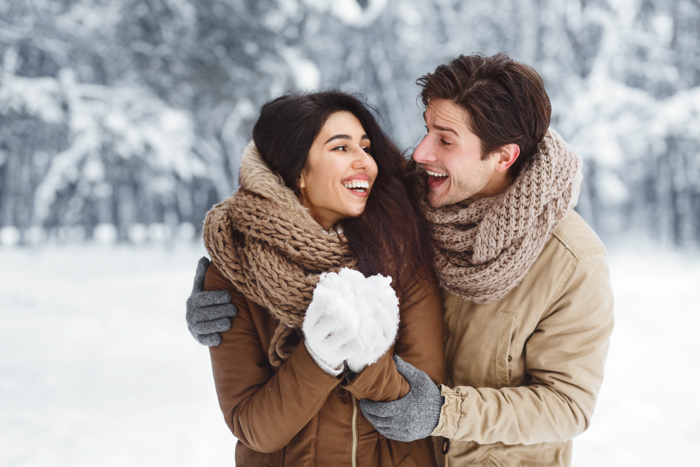
5. Use Winter Fog to Take Gloomy Photos of People
Winter photography tips are not just about sparkly snow and warm, cozy evenings. When it seems like the sun won’t appear anytime soon, you can take moody photos.
For example, you can use winter fog as an eerie background. It enhances the lonely and cold side of winter. Cold days can be gloomy and a bit depressing wit their long nights.
For capturing this, your model can stare off into the distance with their back to your camera. His or her figure should be small compared to the background.
The brightness of the snow will give you enough light to create images similar to the one below.
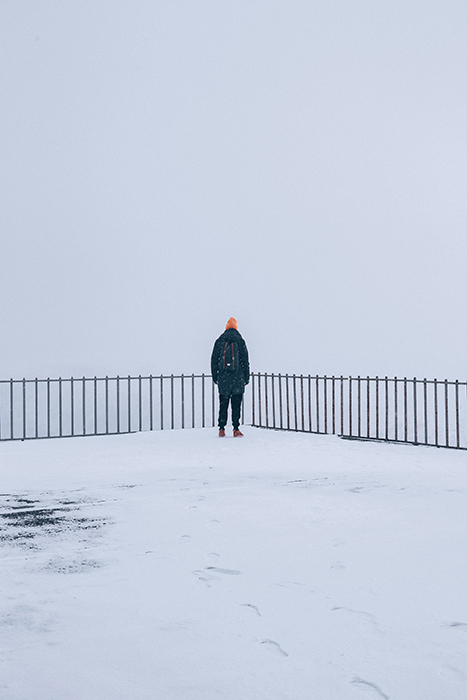
6. Take Your Wildlife Photography Skills to the Next Level by Photographing in Winter
Winter might not the most ideal time for sitting outside for hours, waiting for a wild animal to pass by.
But snow-covered environments can give a great frame to the animals you do spot. Of course, there are some white animals out there. But a lot of them can’t hide as well as in other seasons.
If you don’t want to wander in the cold winter weather, you can even attract animals to your garden or window.
Place food for birds in a feeder, and they are going to come to you.
You can start feeding them when the first frost comes. Then continue it until spring. If they get used to a place where they can find food, they are going to go back regularly. So don’ just attract and then abandon them.
Winter is ideal for bird photo shoots because of its perfectly white tones. This makes it the perfect background for simple yet eye-catching photos.
Because winter photography usually consists of dull colors, things can blend together in an unflattering way. This might take attention away from your subject.
To blur out background distractions, use a large aperture like f/1.4.

7. Make the Most Out of Christmas Photography Using Items You Love
For many people, one of the highlights of winter is Christmas. All the reds and greens are a breath of fresh air during this gloomy season.
Even if you’re not a fan of shooting among cold winter conditions, you’ll love taking Christmas-themed photos.
Christmas-themed flat lays are a great way to highlight the best parts of winter photography. You can photograph your favorite objects, like cups or tree decorations, by using a bird’s eye view.
Of course, not only flat lays work here. Shoot sidewards to reach a shallow depth of field. Blurred lights in the background bring warmth even in cold weather.
To make this idea as fun as possible, take photos of the things you love about Christmas.
You can capture a handmade decoration or a childhood memory. The Christmas table setting is also something you can shoot to get stunning images.
Once the photos are ready, you can turn them into album photos. You and your family will treasure them for years to come. You can even make postcards of these.
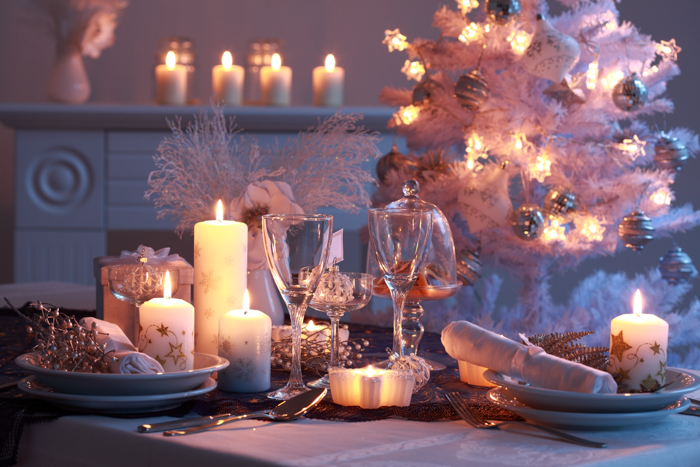
8. Use Food Photography to Capture the Winter Mood
Winter is the perfect time to stay in and cook something delicious. You can slow down a bit and take some time for food photography.
This is one of those photography ideas for winter that you don’t have to leave your house for.
There are typical Christmas foods and typical winter beverages. You can almost smell them just by looking at their images.
You can make mulled wine, hot chocolate, tea, or even coffee, served in a winter-mug. Or you can bake some gingerbread, a cake or anything that reminds you of winter.
It would be a lot to cook proper Christmas dishes before or after Christmas just for fun. So you should experiment with smaller tasks just like cookies.
And you can capture the dishes at Christmas if you have the time before your family eats everything.
These arranged food photography sessions are going to mean a nice preparation for the holidays.

9. Take Macro Photos to Capture the Beauty of Winter
Winter isn’t always fun. This can make it difficult to be excited about photography during this time of year.
But winter isn’t all about gloominess and cold temperatures.
To inspire yourself, start a project that focuses on the beauty of winter. One of the best ways to do that is to photograph snowflakes and frost.
Frost can be found anywhere and always looks stunning. Combined with sunshine, it can result in breathtaking photographs.
This challenge will help you find beauty in simple places and will hopefully cheer you up on a gloomy day.
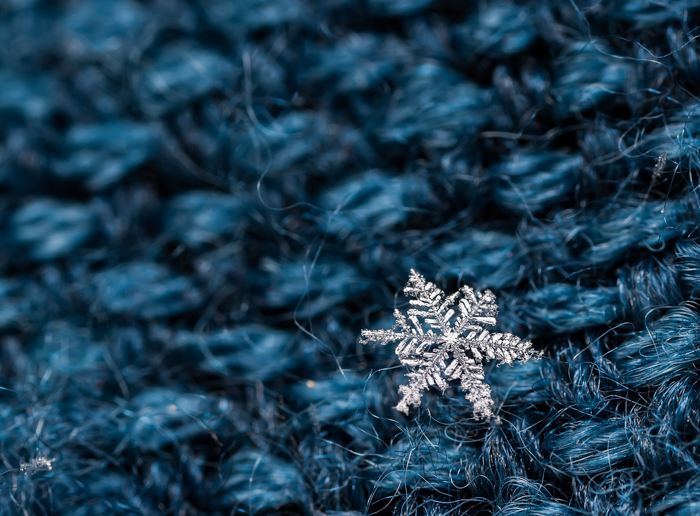
10. Freeze Soap Bubbles for Incredible Results
When it’s very cold outside, you can blow some bubbles and create magic!
All you need are soap bubbles, a macro lens, and good lighting.
Soap bubbles can be difficult to work with, especially if it’s windy outside. Make sure you take photos when the weather is calm.
Blow the bubbles in a location where they can gently land. Branches, flowers, and bushes are perfect for this.
For the best lighting results, shoot when the sun is out.
Photos like this make winter photography more than just a challenging genre.
If you’re lucky, your bubbles will end up getting covered in frost. This will make it seem like you managed to capture snowflakes in a drop of water.
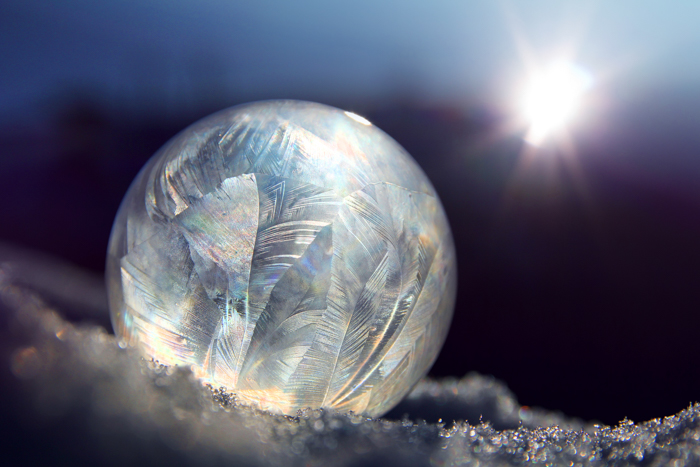
11. Create a Contrast With Autumn and Spring to Enhance The Power of Winter
You can find frozen leaves in winter, the remains of autumn. They are not only beautiful but they make a nice contrast with the previous season.
The first signs of spring, such as little flowers growing from the snow-covered land can also enhance the contrast between two seasons.
These unique contrasts can remind the viewer of the essence of winter. It can freeze the world in a beautiful way, but it doesn’t only mean death. Beautiful things can grow after.
Look for these small signs and tell stories of nature and the circle of life by capturing them.
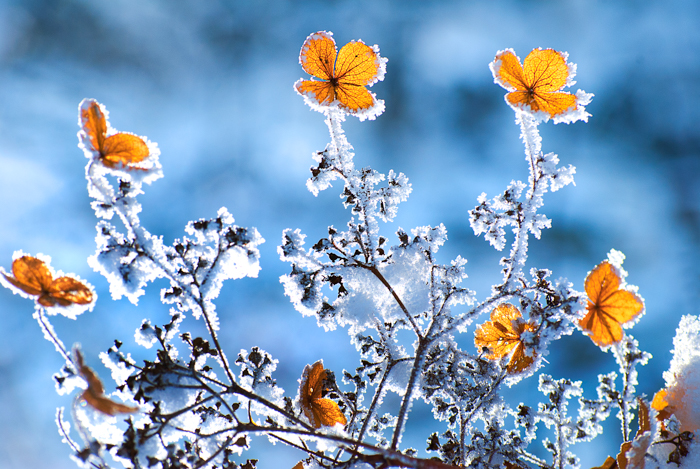
12. Focus on the Connection Between Buildings and Snow
The coldness of winter puts a spotlight on things we might overlook at other times of the year.
For example, it’s impossible not to notice a vibrant light in a colorless, snowy scene.
If you’re a fan of architecture, you can make your subjects stand out even more with the help of snow.
You can use all the negative space to lead a viewer’s eyes to a building.
You can even emphasize shapes that aren’t that visible when they’re surrounded by trees, a blue sky and a busy street.
Architectural photography is usually not strongly connected to winter photography ideas. But if you try it, you’ll realise how different buildings can look at this time of the year.
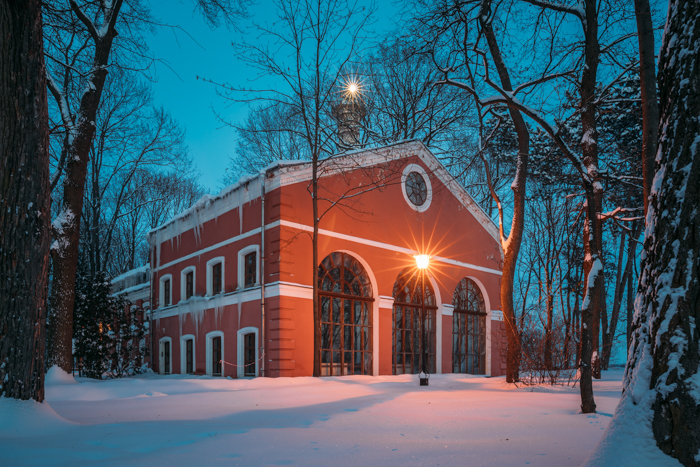
13. Take Landscape Images to Show The Magic of Winter
In winter, nature changes. Snow makes everything look totally different. Go out for a walk into a forest with your camera and capture the beauty of this season.
Prepare for the cold weather, but if you keep moving, a small hike can be a great activity.
You can decide what you would like to enhance with your images. Of course, it depends on the weather.
You can shoot to enhance the golden lights. But this is not the only way to go.
When it comes to winter photos, you might be tempted to make them as warm as possible to make up for the lack of colors. What if you went against that idea?
Make your cold winter photos even colder. Adjust your camera’s white balance. Experiment with different cool tones.
This exercise will help you think outside the box and encourage you to break the rules sometimes.
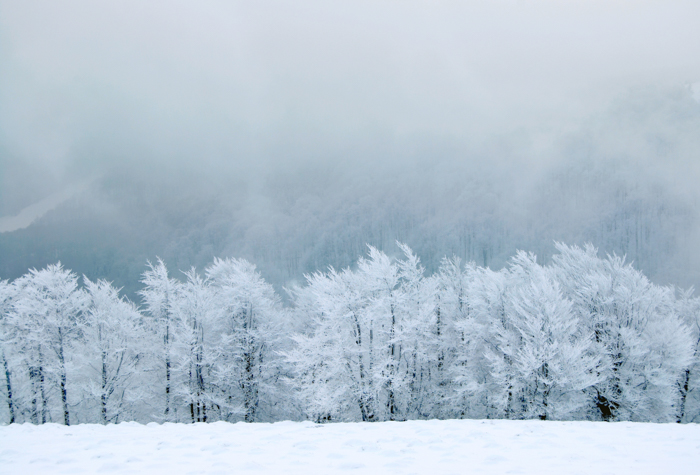
14. Get Up Early for Magical Lights
As everything in winter, sunrises are magical.
If you are lucky and you look ahead a sunny day, the first lights are going to look mesmerizing. Morning lights are usually colder than the lights of a sunset.
Probably the best combination is morning fog with the first signs of a sunny day. The first rays can brighten the whole scene, and make mist look like it’s glowing.
You don’t necessarily need a snowy landscape to create stunning sunrise photos. Any kind of winter weather worth a shot.
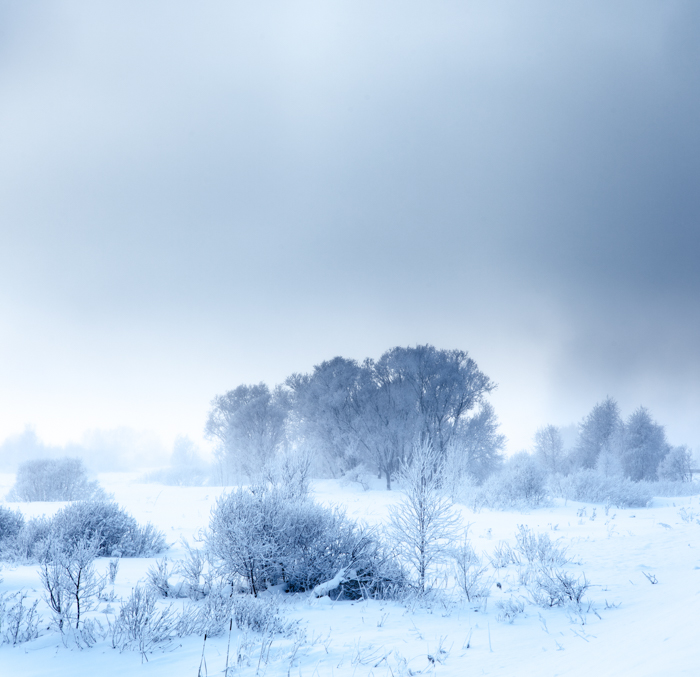
15. Capture Sunsets to Create Dramatic Contrast
One of the best ways to take stunning winter photos is to create contrast.
If possible, use a vibrant sunset or sunrise to create outstanding photos of nature.
The dramatic difference between warm and cool tones will make your photos look striking and atmospheric.
This is ideal for landscape photographers who want to capture the gritty and vulnerable sides of winter.
Also, during the blue hour in winter you can find perfect contrast with the white of the snow. Usually, the sky is lighter than the landscape itself. The dark blue sky of the blue hour is going to make a bit surreal contrast with the snow.

16. Take Creative Snow Falling Photos to Make Playful Images
Falling snow is often used in winter photography. This idea is perfect for having fun and improving your action photography skills at the same time.
You can capture the snowfall itself, but it’s even better to combine it with a portrait photography session.
Your aim is to take sharp photos of falling snow and make your model or models stand out.
To make this process easier, take photos using burst mode. Burst mode is a feature that allows photographers to take multiple photos while holding the shutter.
You can also play with shutter speed to blur the falling snow a little bit.
You can use this technique to take adorable and funny photos of people enjoying winter.
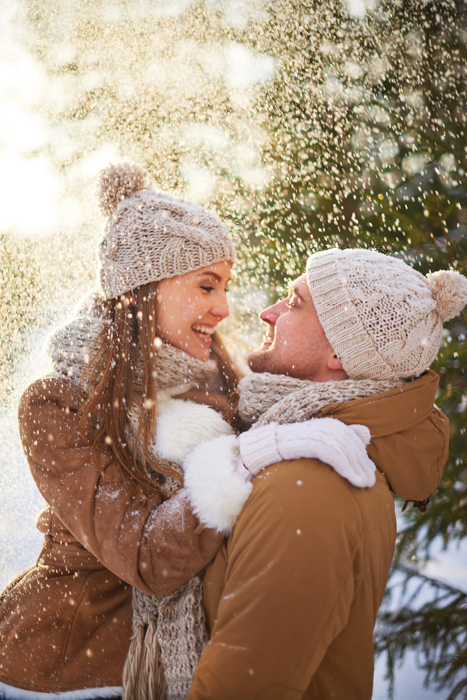
17. Take Adorable Photos of Your Pet in Winter Attire
Our winter photography tips are not just for humans and Christmas decorations.
For this idea, you need to own a pet. If your pet loves spending time outdoors in the winter, you’re lucky!
Adorable pet photos are always in demand. You can turn your pet portraits into stunning works of art every time you go out.
You can use colorful outfits and accessories to make your photos stand out.
If you like the results, you can even use these images as Christmas postcards to your family or friends!
Make sure to reward your pet with treats during and after your photo shoot.
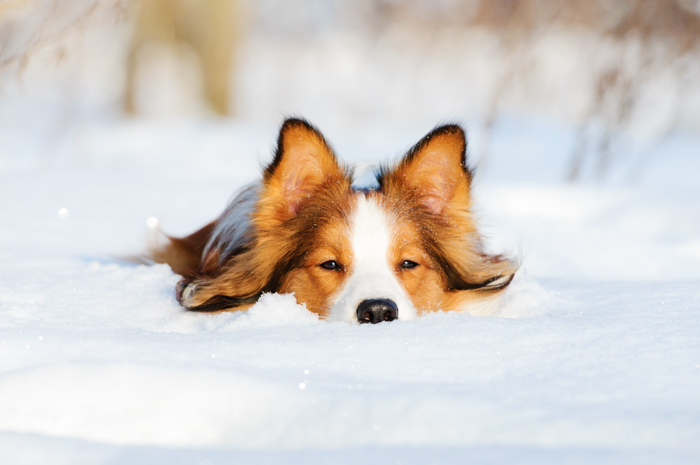
18. Don’t Forget to Take a Wintery Self-Portrait!
It’s as important to photograph others as it is to take self-portraits throughout the process.
During this cold season, don’t forget to take a few photos of yourself surrounded by a stunning winter landscape.
Even if your face isn’t visible in your self-portraits, your results will document your journey.
You can even set a home studio and practice with self-portraits. You can create your own cozy memories by shooting at home surrounded by your favorite Christmas decorations.
But you don’t necessarily have to have a Christmas-themed portrait of yourself. Your favorite pullover can be more than enough.
They might even remind you of how much you’ve progressed as an artist.
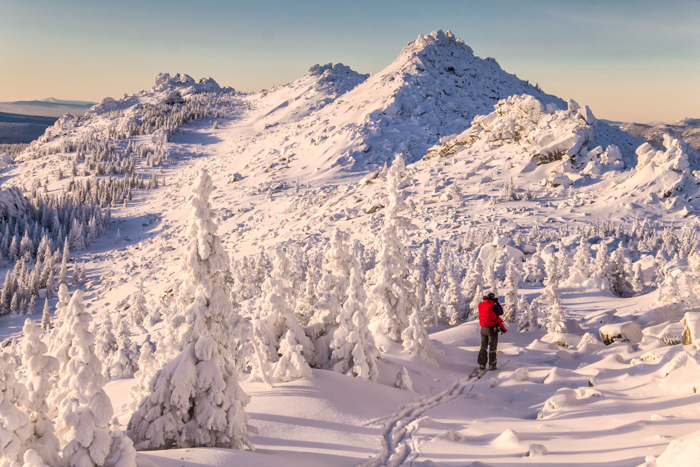
Winter is coming, folks.
Before it arrives, satisfy your creative needs with plans, mood boards, and ideas. These will make your winter photography a success.
Consider our winter photography tips, and experiment with them to get outstanding images. Snowy days are usually rare in most parts of the world. Your images are going to be more unique just by showing some snow.
When winter is here, you’ll be ready to take your best photos yet. Share this article.
----------------------------------------------------------------------------------------------------------------------
PHOTOGRAPHY FREEBIE:
How to make money with your Photography even if you're not a Pro.
Copy & paste this link into your browser, click ENTER, and enjoy:
https://mrdarrylt.blogspot.com/2020/01/how-to-make-500-month-from-your.html
or
https://www.photography-jobs.net/?hop=darryl54
----------------------------------------------------------------------------------------------------------------------
Visit me on Facebook and post your pictures.
https://www.facebook.com/Darryl-T-363867387724297/------------------------------------------------------------------------------------------------------------------------
Need a camera? Try this link for discounted prices: https://ebay.to/2Smb1ho
































